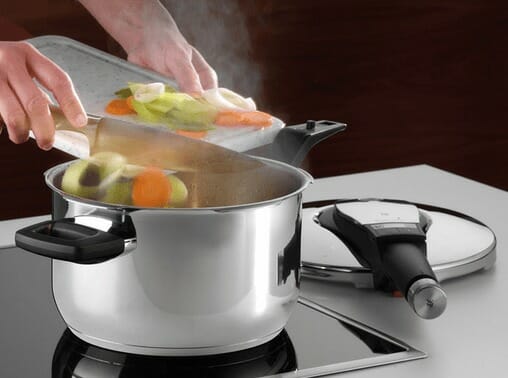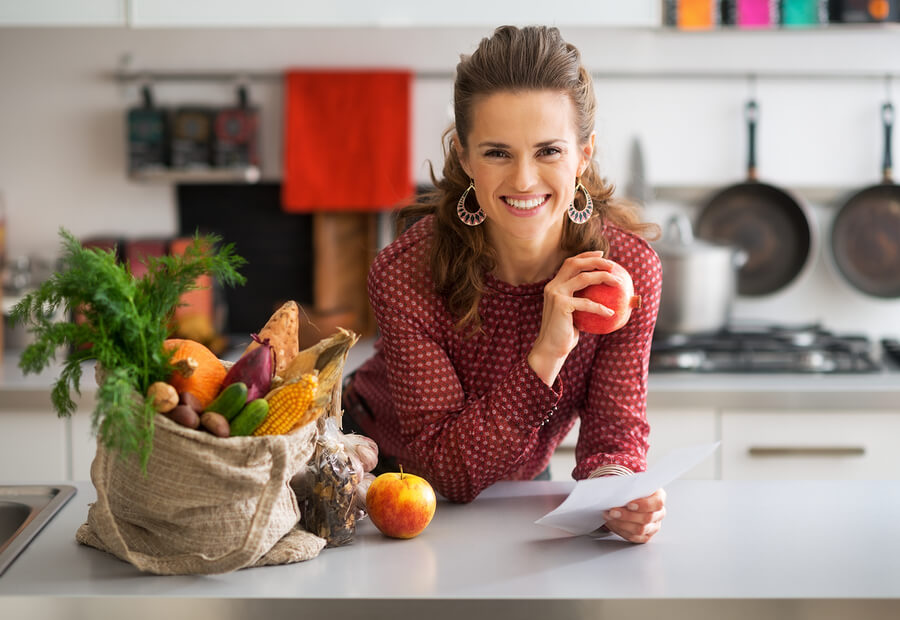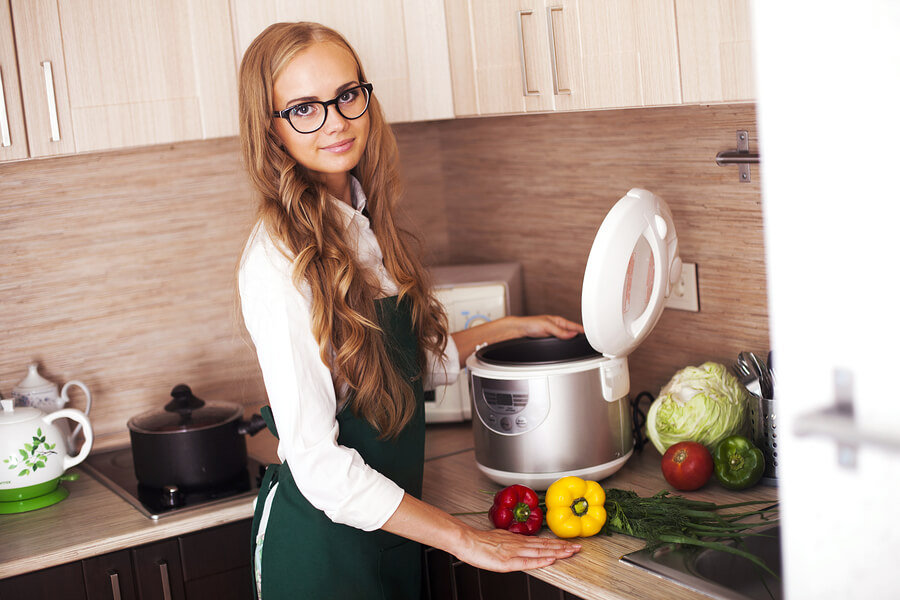Pressure cookers have eased our lives to a great extent. Be it a conventional or a slow cooker, there is much more ease while cooking with these gadgets. Some of them are so advanced that they have taken over other kitchenware. Pressure cookers reduce the time span of cooking, and the food quality is excellent. So, they are considered ideal for the job. However, there are a few concerns while using pressure cookers.
Though they are a customer friendly product, there is one major aspect of cooking for which pressure cookers are being held questionable. Is a pressure cooker able to ultimately deliver a recipe as it is meant to be?. That is the big question. It doesn’t sound too great if you don’t get the anticipated final food product no matter how convenient and ease the whole process is. Therefore, a good pressure cooker will always enhance the ability to produce your meal according to your recipe.
This article is meant to educate you regarding recipe conversion through pressure cookers. You will be amazed to find out how easily you can convert a wide range of recipes using your very own pressure cooker. As we discuss recipe conversion, you should first have enough prerequisite knowledge about the pressure cooker usage and recipes.
Recipe Conversion For a Pressure Cooker?
Most people want to know what type of recipes can be converted through a pressure cooker. To cut off the suspense, here is the answer:
All conventional recipes can be converted through a pressure cooker. However, there are certain conditions that need to be fulfilled. It is more dependent on your view of how you want your final product to look and taste. Therefore, you might well want to practice more for a perfect reflection of your recipe.
Types of Recipes
If the recipes are friendly for both ovens and stove tops, your favorite vegetables and soups can have the desired look and taste. It also depends on the type of cooking method that you adopt. Several cooking methods are friendly for pressure cookers. Here are some of those methods:
- Tiered Cooking
- Infusion Cooking
- Phased Cooking
- Infusion Cooking
- Pre-Cooking
If you wish to practice any of these cooking techniques, you should know some of the basics of pressure cooking. It will make your cooking experience a lot safer and more enjoyable, ensuring that your pressure cooker runs well for a longer time.
Cooking time charts are also quite handy, especially if you are new to your pressure cooker. Accurate timing plays a vital role in getting the recipe right.
Minimal Oil Usage is also of great importance. You can go for a maximum of a quarter cup of oil and fats in a pressure cooker. With recipes that involve creams and milk, ensure that you add them after the pressure is removed. Cream and milk tend to froth and foam.
Essentials For Recipe Conversion
There are no standard procedures that can guide you to a perfect recipe conversion. It is primarily based on how experienced you are with pressure cooking. You will learn best when you execute a recipe yourself. No guide book can make you an expert recipe converter in an instant.
Most of the time, trial and error method will guide you to the best results. A recipe may not come out perfect in the first attempt, regardless of the fact that you used a cooker or a pan. Practice will take you there. During this learning curve, make sure that you are taking down notes about color, taste, and temperature at different instances. It will help you when you try the recipe next time.
In almost all the recipes, there are the following elements that need to be taken care of:
- Accurate timing
- Appropriate amount of liquid
- Pressurizing and depressurizing methods
- Cooking techniques and methods
We will discuss these four aspects in details in this article.
Importance of Correct Timing
If you don’t like dry and overcooked food, you might well want to focus on timing. If you are not good at monitoring your cooking time, more often than not, you will end up with unwanted smell and taste in your food. According to standards, a 15 psi pressure cooker will cook your recipe in one-third of the time it should take when cooked on a stove top or an oven. All of your recipe timings will then automatically be reduced by one-third.
To help you further, we suggest you go for a cooking time chart. It will guide you with more accuracy and precision while dealing with food. If you ensure that your pressure cooker has similar or close features to the pressure cooker in the guide, it will give you better results, taste, and food quality. With each pressure cooker, the amount of liquids used is also subject to variations. Therefore, you should take that into account as well.
Pressure Release Methods

Pressure release is quite crucial for the finished product. Whether you should drop the pressure instantly or whether you should wait for the cooker to cool down to a certain degree depends on your recipe. When you refer to a recipe guide, it will tell you about when and how to drop the pressure inside a cooker. There are different pressure release mechanisms in pressure cookers. You should also know exactly how to use them before you start cooking with the pressure cookers.
Liquid Content
This is probably the most variable element of pressure cooking to the conventional open pan cooking. In open pan cooking, the amount of liquid is generally kept higher because it tends to evaporate at a rapidly. However, it is not the case in pressure cookers because the lid is kept close. Hence the amount of liquid required for recipes in pressure cookers is comparably lesser than in open pans.
Also, since the pressure cookers are closed systems, the ingredients tend to lose their juices and liquids during cooking due to the extra pressure.
The liquid amount is critical because you don’t want your recipe to turn soggy. One of the most common mistakes that people make while transforming to pressure cooking is that they don’t usually take consideration about water level inside the cooker.
Appropriate Cooking Techniques
You will be surprised to know that there are more pressure cooking methods than you ever knew. Some of these methods use moist heat, i.e. steam, for cooking. Recipes that involve Boiling, Stewing, Steaming, Braising, Poaching and baking can work well inside pressure cookers.
This is where you should know exactly what container to use for cooking. If your recipe involves some other methods, pressure cookers may not be the ideal kitchenware to use.
Interestingly, a recipe can have more than one way of cooking. You should pick a certain recipe that is closest to the original recipe. It will give you better results.
Troubleshooting
Even after making sure that you handled all the things well, and your recipe still doesn’t look great, then you need not worry. Some methods will let you determine where you might have made the mistake so that you don’t do it next time. Here are some food fixes that can save your day.
Soggy Food

When you depressurize and find out that your food has excessive liquid, you can still reclaim your dish through these easy techniques:
- Boil your dish without covering the lid. It will evaporate extra water content.
- Add thickening material such as a powder, which doesn’t affect the taste a great deal.
- If there is too much excessive liquid, you can simply ladle it off and save for future.
Undercooked Food
The next big concern is that your food may not be sufficiently cooked. If your dish seems undercooked, put the lid back on for a maximum of five minutes and then check the results. If the outcome is still unsatisfactory, you may cook it with the lid off under your supervision to get the exact color and smell from your dish.
Overcooked Food
People that take extra care tend to overcook the food. You may well end up with dry and burnt food in such a case. Vegetables typically cook in a relatively shorter time than other foods; they can overcook quite quickly if not supervised. If your food is overcooked, and your vegetables turn too soft, you can remove them from the dish, puree them and add to the gravy. In this way, not only will you be able to reuse the ingredients, but it can also add thickness to your food in case it turned thin.
Burnt and Scorched Food
Scorching commonly occurs in ingredients with higher sugar and starch content. To avoid scorching, you can place the ingredients in the form of layers. Ensure that the sugary ingredients are not directly in contact with the bottom of the cooker. Not only will it save your food from scorching but it will also protect the bottom layer of your cooker from turning black.
While dealing with such foods, also don’t stir too much. It may bring all the ingredients down to the bottom, which you don’t want to happen.
Slow Cooker Recipe Conversion to Pressure Cookers
Slow cookers are perfect for those who have a lot of time for food preparation. However, what do you do if you have too many errands to run? One can find it hard to prepare ingredients in the morning for the evening meal. This is why pressure cookers are so handy. You can convert all the slow cooker techniques to pressure cookers.
You can have the exact quality of food that you get from slow cookers at a higher speed. It is slightly different when you are working with pressure cookers. Here are some techniques that work differently in pressure cookers than in slow cookers.
Filling
You can stuff a slow cooker up to its mouth because it is mostly open-lid cooking. However, when you are dealing with pressure cookers, there is a strict level indicated in most pressure cookers. Your food will be better cooked if you keep within those limits. The reason for that is that pressure cookers use the steam that provides extra pressure and heat so that the food softens and cooks faster. If you do not allow enough space for the steam to build up, you will not get efficient results.
Also, it is a precautionary measure to stay ‘inside the line’ because you don’t want your pressure cooker to blast off due to extreme pressure.
Thickening
In many recipes for slow cooking, you might well add corn flour or a Roux to turn the food thicker. However, in pressure cookers, these thickening agents can be subjected to scorching because of the starch content inside them. Therefore, when you thicken food in a pressure cooker, you should add the thickening agents once you have depressurized the food.
Conclusion

To summarize the discussion, it is quite easy to convert your conventional recipes to pressure cookers. There are quite a few benefits of doing so because you can produce the same quality of food in lesser time, which is probably the primary objective of using a pressure cooker.
Modern day pressure cookers are more advanced when it comes to reliability and safety. So if you keep a check on all the key factors discussed in this article, you are guaranteed to have fruitful results for your efforts in the kitchen.
As a recommendation, we suggest you should seek information about the most efficient pressure cookers because there is quite a large variety of them available these days. There are electric pressure cookers also available which have more controls and are more user-friendly than conventional pressure cookers. All in all, a good pressure cooker along with appropriate cooking techniques and considerations will ensure you mouth-watering and delicious food every time.


Leave a Reply